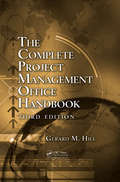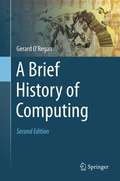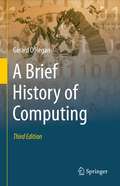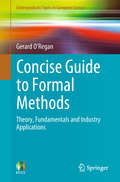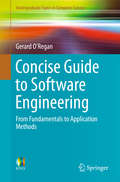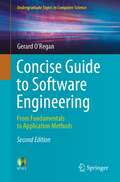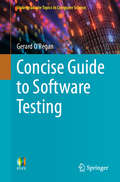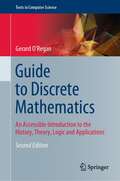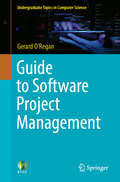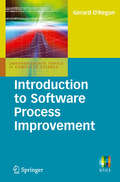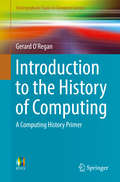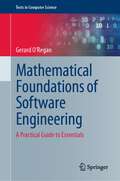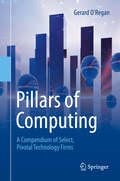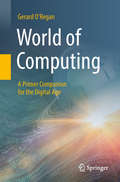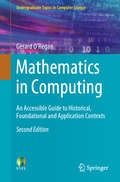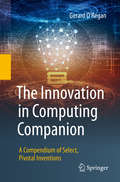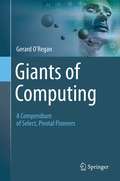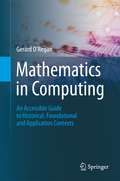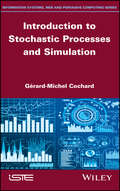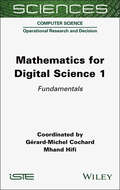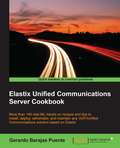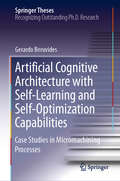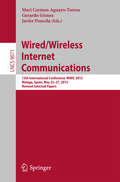- Table View
- List View
The Complete Project Management Office Handbook (ESI International Project Management Series)
by Gerard M. HillThis updated and completely revised edition of a bestseller extends the concepts and considerations of modern project management into the realm of project management oversight, control, and support. Illustrating the implications of project management in today’s organizations, The Complete Project Management Office Handbook, Third Edition explains how to use the project management office (PMO) as a business integrator to influence project outcomes in a manner that serves both project and business management interests.Helping you determine if a PMO is right for your organization, this edition presents a five-stage PMO competency continuum to help you understand how to develop PMOs at different competency levels and associated functionalities. It also identifies five progressive PMO development levels to help you identify which level is best for your organization. Updates to this edition include: A refinement of the 20 PMO functions that guide PMO setup and operations A new section that provides an effective evaluation of PMO maturity indicators based on the prescribed 20 PMO functions presented in the handbook A new section on Establishing a Project Management Office that details a comprehensive process for determining the needs, purpose, and functionality for a new PMO Best practices that have cross-industry value and applicability The book includes checklists, detailed process steps, and descriptive guidance for developing PMO functional capability. The up-to-date PMO model defined will not only help you better understand business practices in project management, but will also help you to adapt and integrate those practices into the project management environment in your organization.For anyone associated with start-up and smaller PMOs, the book explains what can be done to create less rigorous PMO functional capabilities. It also includes helpful insights for those who need to specify and demonstrate "quick-wins" and early PMO-based accomplishments in their organization.
A Brief History of Computing
by Gerard O'ReganThis lively and fascinating text traces the key developments in computation - from 3000 B.C. to the present day - in an easy-to-follow and concise manner. Topics and features: ideal for self-study, offering many pedagogical features such as chapter-opening key topics, chapter introductions and summaries, exercises, and a glossary; presents detailed information on major figures in computing, such as Boole, Babbage, Shannon, Turing, Zuse and Von Neumann; reviews the history of software engineering and of programming languages, including syntax and semantics; discusses the progress of artificial intelligence, with extension to such key disciplines as philosophy, psychology, linguistics, neural networks and cybernetics; examines the impact on society of the introduction of the personal computer, the World Wide Web, and the development of mobile phone technology; follows the evolution of a number of major technology companies, including IBM, Microsoft and Apple.
A Brief History of Computing
by Gerard O'ReganThis lively and fascinating text traces the key developments in computation – from 3000 B.C. to the present day – in an easy-to-follow and concise manner. Topics and features: ideal for self-study, offering many pedagogical features such as chapter-opening key topics, chapter introductions and summaries, exercises, and a glossary; presents detailed information on major figures in computing, such as Boole, Babbage, Shannon, Turing, Zuse and Von Neumann; discusses the earliest computers developed in the United States, Germany and Britain; discusses the development of the IBM 360 family of computers and its importance; discusses the invention of the transistor and integrated circuit; discusses the birth of the software industry and the evolution of human-computer interaction; reviews the history of programming languages, operating systems and software engineering; discusses the progress of artificial intelligence; discusses the invention of the microprocessor and the development of home and personal computers; examines the impact on society of the introduction of the personal computer, the World Wide Web, and the development of mobile phone technology; discusses smart phones and social media and the challenge of fake news; reviews a miscellany of innovations in the computing field such as cloud computing, the Internet of Things, and Quantum Computing; discusses legal aspects of computing and the professional responsibilities of computer professionals.
Concise Guide to Formal Methods
by Gerard O'ReganThis invaluable textbook/reference provides an easy-to-read guide to the fundamentals of formal methods, highlighting the rich applications of formal methods across a diverse range of areas of computing.Topics and features: introduces the key concepts in software engineering, software reliability and dependability, formal methods, and discrete mathematics; presents a short history of logic, from Aristotle’s syllogistic logic and the logic of the Stoics, through Boole’s symbolic logic, to Frege’s work on predicate logic; covers propositional and predicate logic, as well as more advanced topics such as fuzzy logic, temporal logic, intuitionistic logic, undefined values, and the applications of logic to AI; examines the Z specification language, the Vienna Development Method (VDM) and Irish School of VDM, and the unified modelling language (UML); discusses Dijkstra’s calculus of weakest preconditions, Hoare’s axiomatic semantics of programming languages, and the classical approach of Parnas and his tabular expressions; provides coverage of automata theory, probability and statistics, model checking, and the nature of proof and theorem proving; reviews a selection of tools available to support the formal methodist, and considers the transfer of formal methods to industry; includes review questions and highlights key topics in every chapter, and supplies a helpful glossary at the end of the book.This stimulating guide provides a broad and accessible overview of formal methods for students of computer science and mathematics curious as to how formal methods are applied to the field of computing.
Concise Guide to Software Engineering
by Gerard O'ReganThis essential textbook presents a concise introduction to the fundamental principles of software engineering, together with practical guidance on how to apply the theory in a real-world, industrial environment. The wide-ranging coverage encompasses all areas of software design, management, and quality.Topics and features: presents a broad overview of software engineering, including software lifecycles and phases in software development, and project management for software engineering; examines the areas of requirements engineering, software configuration management, software inspections, software testing, software quality assurance, and process quality; covers topics on software metrics and problem solving, software reliability and dependability, and software design and development, including Agile approaches; explains formal methods, a set of mathematical techniques to specify and derive a program from its specification, introducing the Z specification language; discusses software process improvement, describing the CMMI model, and introduces UML, a visual modelling language for software systems; reviews a range of tools to support various activities in software engineering, and offers advice on the selection and management of a software supplier; describes such innovations in the field of software as distributed systems, service-oriented architecture, software as a service, cloud computing, and embedded systems; includes key learning topics, summaries and review questions in each chapter, together with a useful glossary.This practical and easy-to-follow textbook/reference is ideal for computer science students seeking to learn how to build high quality and reliable software on time and on budget. The text also serves as a self-study primer for software engineers, quality professionals, and software managers.
Concise Guide to Software Engineering: From Fundamentals to Application Methods (Undergraduate Topics in Computer Science)
by Gerard O'ReganThis textbook presents a concise introduction to the fundamental principles of software engineering, together with practical guidance on how to apply the theory in a real-world, industrial environment. The wide-ranging coverage encompasses all areas of software design, management, and quality.Topics and features: presents a broad overview of software engineering, including software lifecycles and phases in software development, and project management for software engineering; examines the areas of requirements engineering, software configuration management, software inspections, software testing, software quality assurance, and process quality; covers topics on software metrics and problem solving, software reliability and dependability, and software design and development, including Agile approaches; explains formal methods, a set of mathematical techniques to specify and derive a program from its specification, introducing the Z specification language; discusses software process improvement, describing the CMMI model, and introduces UML, a visual modelling language for software systems; reviews a range of tools to support various activities in software engineering, and offers advice on the selection and management of a software supplier; describes such innovations in the field of software as distributed systems, service-oriented architecture, software as a service, cloud computing, and embedded systems; includes key learning topics, summaries and review questions in each chapter, together with a useful glossary.This practical and easy-to-follow textbook/reference is ideal for computer science students seeking to learn how to build high quality and reliable software on time and on budget. The text also serves as a self-study primer for software engineers, quality professionals, and software managers.
Concise Guide to Software Testing (Undergraduate Topics in Computer Science)
by Gerard O'ReganThis practically-focused textbook provides a concise and accessible introduction to the field of software testing, explaining the fundamental principles and offering guidance on applying the theory in an industrial environment.Topics and features: presents a brief history of software quality and its influential pioneers, as well as a discussion of the various software lifecycles used in software development; describes the fundamentals of testing in traditional software engineering, and the role that static testing plays in building quality into a product; explains the process of software test planning, test analysis and design, and test management; discusses test outsourcing, and test metrics and problem solving; reviews the tools available to support software testing activities, and the benefits of a software process improvement initiative; examines testing in the Agile world, and the verification of safety critical systems; considers the legal and ethical aspects of software testing, and the importance of software configuration management; provides key learning topics and review questions in every chapter, and supplies a helpful glossary at the end of the book.This easy-to-follow guide is an essential resource for undergraduate students of computer science seeking to learn about software testing, and how to build high quality and reliable software on time and on budget. The work will also be of interest to industrialists including software engineers, software testers, quality professionals and software managers, as well as the motivated general reader.
Ethical and Legal Aspects of Computing: A Professional Perspective from Software Engineering (Undergraduate Topics in Computer Science)
by Gerard O'ReganThis textbook presents an overview of the critically important ethical and legal issues that arise in the computing field and provides a professional perspective from software engineering. The author gained exposure to these aspects of computing while working as a software engineer at Motorola in Ireland, where he coordinated the patent programme and worked with several software suppliers. Topics and features: Presents a broad overview of ethics and the lawIncludes key learning topics, summaries, and review questions in each chapter, together with a useful glossaryDiscusses the professional responsibility of computer professionalsExplores ethics in various civilisations and religious traditionsDiscusses ethical software engineering and ethical outsourcingConsiders what is fair and ethical in data scienceDescribes ethical challenges that arise in social media and the AI fieldReviews intellectual property including patents, copyright and trademarks This practical and easy-to-follow textbook/reference is ideal for computer science students seeking to understand legal and ethical aspects of computing. The text also serves as a concise self-study primer for software engineers and software managers.
Guide to Discrete Mathematics: An Accessible Introduction to the History, Theory, Logic and Applications (Texts in Computer Science)
by Gerard O'ReganThis stimulating textbook presents a broad and accessible guide to the fundamentals of discrete mathematics, highlighting how the techniques may be applied to various exciting areas in computing. The text is designed to motivate and inspire the reader, encouraging further study in this important skill. Features: This book provides an introduction to the building blocks of discrete mathematics, including sets, relations and functions; describes the basics of number theory, the techniques of induction and recursion, and the applications of mathematical sequences, series, permutations, and combinations; presents the essentials of algebra; explains the fundamentals of automata theory, matrices, graph theory, cryptography, coding theory, language theory, and the concepts of computability and decidability; reviews the history of logic, discussing propositional and predicate logic, as well as advanced topics such as the nature of theorem proving; examines the field of software engineering, including software reliability and dependability and describes formal methods; investigates probability and statistics and presents an overview of operations research and financial mathematics.
Guide to Software Project Management (Undergraduate Topics in Computer Science)
by Gerard O'ReganThis essential textbook presents an overview of software project management in an ethical and responsible software engineering environment. The book covers the essentials of software project management, and highlights the importance of ethics and professional responsibility as part of the skill set of the modern project manager. Topics and features: Presents a solid overview of software project management Discusses professional and ethical responsibilities of project managers Presents an overview of ethical software engineering Reviews project planning and scheduling, project monitoring and control, risk management and project closure Discusses quality management of software projects Presents an overview of legal and ethical aspects of outsourcing Discusses project management for both traditional and Agile projects Reviews a selection of tools & metrics to support project management Discusses best practice (Prince 2, PMP and CMMI) to improve project management Includes key learning topics, summaries, and review questions in each chapter, together with a useful glossary This practical and easy-to-follow textbook/reference is ideal for computer science students seeking to understand software project management. The text also serves as a self-study primer for software engineers, project managers and software managers. Dr. Gerard O’Regan is an international lecturer in Maths/Computing with research interests in software quality, software process improvement, mathematical approaches to software quality, and the history of computing. He is the author of several books with Springer, including Concise Guide to Software Engineering, Ethical and Legal Aspects of Computing, and A Brief History of Computing.
Introduction to Software Process Improvement
by Gerard O'ReganThis textbook is a systematic guide to the steps in setting up a Capability Maturity Model Integration (CMMI) improvement initiative. Readers will learn the project management practices necessary to deliver high-quality software solutions to the customer on time and on budget. The text also highlights how software process improvement can achieve specific business goals to provide a tangible return on investment. Topics and features: supplies review questions, summaries and key topics for each chapter, as well as a glossary of acronyms; describes the CMMI model thoroughly, detailing the five maturity levels; provides a broad overview of software engineering; reviews the activities and teams required to set up a CMMI improvement initiative; examines in detail the implementation of CMMI in a typical organization at each of the maturity levels; investigates the various tools that support organizations in improving their software engineering maturity; discusses the SCAMPI appraisal methodology.
Introduction to the History of Computing
by Gerard O'ReganTracing the story of computing from Babyloniancounting boards to smartphones, this inspiring textbook provides a conciseoverview of the key events in the history of computing, together withdiscussion exercises to stimulate deeper investigation into this fascinatingarea. Features: provides chapter introductions, summaries, key topics, and reviewquestions; includes an introduction to analogue and digital computers, and to thefoundations of computing; examines the contributions of ancient civilisationsto the field of computing; covers the first digital computers, and the earliestcommercial computers, mainframes and minicomputers; describes the earlydevelopment of the integrated circuit and the microprocessor; reviews theemergence of home computers; discusses the creation of the Internet, theinvention of the smartphone, and the rise of social media; presents a shorthistory of telecommunications, programming languages, operating systems,software engineering, artificial intelligence, and databases.
Mathematical Foundations of Software Engineering: A Practical Guide to Essentials (Texts in Computer Science)
by Gerard O'ReganThis textbook presents an introduction to the mathematical foundations of software engineering. It presents the rich applications of mathematics in areas such as error-correcting codes, cryptography, the safety and security critical fields, the banking and insurance fields, as well as traditional engineering applications. Topics and features: Addresses core mathematics for critical thinking and problem solving Discusses propositional and predicate logic and various proof techniques to demonstrate the correctness of a logical argument. Examines number theory and its applications to cryptography Considers the underlying mathematics of error-correcting codes Discusses graph theory and its applications to modelling networks Reviews tools to support software engineering mathematics, including automated and interactive theorem provers and model checking Discusses financial software engineering, including simple and compound interest, probability and statistics, and operations research Discusses software reliability and dependability and explains formal methods used to derive a program from its specification Discusses calculus, matrices, vectors, complex numbers, and quaternions, as well as applications to graphics and robotics Includes key learning topics, summaries, and review questions in each chapter, together with a useful glossary This practical and easy-to-follow textbook/reference is ideal for computer science students seeking to learn how mathematics can assist them in building high-quality and reliable software on time and on budget. The text also serves as an excellent self-study primer for software engineers, quality professionals, and software managers.
Pillars of Computing
by Gerard O'ReganThis accessible compendium examines a collection of significant technology firms that have helped to shape the field of computing and its impact on society. Each company is introduced with a brief account of its history, followed by a concise account of its key contributions. The selection covers a diverse range of historical and contemporary organizations from pioneers of e-commerce to influential social media companies. Features: presents information on early computer manufacturers; reviews important mainframe and minicomputer companies; examines the contributions to the field of semiconductors made by certain companies; describes companies that have been active in developing home and personal computers; surveys notable research centers; discusses the impact of telecommunications companies and those involved in the area of enterprise software and business computing; considers the achievements of e-commerce companies; provides a review of social media companies.
World of Computing: A Primer Companion For The Digital Age
by Gerard O'ReganThis engaging work provides a concise introduction to the exciting world of computing, encompassing the theory, technology, history, and societal impact of computer software and computing devices. Spanning topics from global conflict to home gaming, international business, and human communication, this text reviews the key concepts unpinning the technology which has shaped the modern world.Topics and features: introduces the foundations of computing, the fundamentals of algorithms, and the essential concepts from mathematics and logic used in computer science; presents a concise history of computing, discussing the historical figures who made important contributions, and the machines which formed major milestones; examines the fields of human−computer interaction, and software engineering; provides accessible introductions to the core aspects of programming languages, operating systems, and databases; describes the Internet revolution, the invention of the smartphone, and the rise of social media, as well as the Internet of Things and cryptocurrencies; explores legal and ethical aspects of computing, including issues of hacking and cybercrime, and the nature of online privacy, free speech and censorship; discusses such innovations as distributed systems, service-oriented architecture, software as a service, cloud computing, and embedded systems; includes key learning topics and review questions in every chapter, and a helpful glossary.Offering an enjoyable overview of the fascinating and broad-ranging field of computing, this easy-to-understand primer introduces the general reader to the ideas on which the digital world was built, and the historical developments that helped to form the modern age.
Mathematics in Computing: An Accessible Guide to Historical, Foundational and Application Contexts (Undergraduate Topics in Computer Science)
by Gerard O’ReganThis illuminating textbook provides a concise review of the core concepts in mathematics essential to computer scientists. Emphasis is placed on the practical computing applications enabled by seemingly abstract mathematical ideas, presented within their historical context. The text spans a broad selection of key topics, ranging from the use of finite field theory to correct code and the role of number theory in cryptography, to the value of graph theory when modelling networks and the importance of formal methods for safety critical systems.This fully updated new edition has been expanded with a more comprehensive treatment of algorithms, logic, automata theory, model checking, software reliability and dependability, algebra, sequences and series, and mathematical induction.Topics and features: includes numerous pedagogical features, such as chapter-opening key topics, chapter introductions and summaries, review questions, and a glossary; describes the historical contributions of such prominent figures as Leibniz, Babbage, Boole, and von Neumann; introduces the fundamental mathematical concepts of sets, relations and functions, along with the basics of number theory, algebra, algorithms, and matrices; explores arithmetic and geometric sequences and series, mathematical induction and recursion, graph theory, computability and decidability, and automata theory; reviews the core issues of coding theory, language theory, software engineering, and software reliability, as well as formal methods and model checking; covers key topics on logic, from ancient Greek contributions to modern applications in AI, and discusses the nature of mathematical proof and theorem proving; presents a short introduction to probability and statistics, complex numbers and quaternions, and calculus.This engaging and easy-to-understand book will appeal to students of computer science wishing for an overview of the mathematics used in computing, and to mathematicians curious about how their subject is applied in the field of computer science. The book will also capture the interest of the motivated general reader.
The Innovation in Computing Companion: A Compendium of Select, Pivotal Inventions
by Gerard O’ReganThis encyclopedic reference provides a concise and engaging overview of the groundbreaking inventions and conceptual innovations that have shaped the field of computing, and the technology that runs the modern world. Each alphabetically-ordered entry presents a brief account of a pivotal innovation and the great minds behind it, selected from a wide range of diverse topics.Topics and features:Describes the development of Babbage’s computing machines, Leibniz’s binary arithmetic, Boole’s symbolic logic, and Von Neumann architectureReviews a range of historical analog and digital computers, significant mainframes and minicomputers, and pioneering home and personal computersDiscusses a selection of programming languages and operating systems, along with key concepts in software engineering and commercial computingExamines the invention of the transistor, the integrated circuit, and the microprocessorRelates the history of such developments in personal computing as the mouse, the GUI, Atari video games, and Microsoft OfficeSurveys innovations in communications, covering mobile phones, WiFi, the Internet and World Wide Web, e-commerce, smartphones, social media, and GPSPresents coverage of topics on artificial intelligence, the ATM, digital photography and digital music, robotics, and WikipediaContains self-test quizzes and a helpful glossaryThis enjoyable compendium will appeal to the general reader curious about the intellectual milestones that led to the digital age, as well as to the student of computer science seeking a primer on the history of their field.Dr. Gerard O'Regan is a CMMI software process improvement consultant with research interests including software quality and software process improvement, mathematical approaches to software quality, and the history of computing. He is the author of such Springer titles as World of Computing, Concise Guide to Formal Methods, Concise Guide to Software Engineering, and Guide to Discrete Mathematics.
Giants of Computing: A Compendium of Select, Pivotal Pioneers
by Gerard O’reganIt has been upon the shoulders of giants that the modern world has been forged. This accessible compendium presents an insight into the great minds responsible for the technology which has transformed our lives. Each pioneer is introduced with a brief biography, followed by a concise account of their key contributions to their discipline. The selection covers a broad spread of historical and contemporary figures from theoreticians to entrepreneurs, highlighting the richness of the field of computing. Suitable for the general reader, this concise and easy-to-read reference will be of interest to anyone curious about the inspiring men and women who have shaped the field of computer science.
Mathematics in Computing
by Gerard O’reganThis clearly written and enlightening textbook provides a concise, introductory guide to the key mathematical concepts and techniques used by computer scientists. Topics and features: ideal for self-study, offering many pedagogical features such as chapter-opening key topics, chapter introductions and summaries, review questions, and a glossary; places our current state of knowledge within the context of the contributions made by early civilizations, such as the ancient Babylonians, Egyptians and Greeks; examines the building blocks of mathematics, including sets, relations and functions; presents an introduction to logic, formal methods and software engineering; explains the fundamentals of number theory, and its application in cryptography; describes the basics of coding theory, language theory, and graph theory; discusses the concept of computability and decideability; includes concise coverage of calculus, probability and statistics, matrices, complex numbers and quaternions.
Introduction to Distributed Algorithms
by Gerard TelDistributed algorithms have been the subject of intense development over the last twenty years. The second edition of this successful textbook provides an up-to-date introduction both to the topic, and to the theory behind the algorithms. The clear presentation makes the book suitable for advanced undergraduate or graduate courses, whilst the coverage is sufficiently deep to make it useful for practising engineers and researchers. The author concentrates on algorithms for the point-to-point message passing model, and includes algorithms for the implementation of computer communication networks. Other key areas discussed are algorithms for the control of distributed applications (wave, broadcast, election, termination detection, randomized algorithms for anonymous networks, snapshots, deadlock detection, synchronous systems), and fault-tolerance achievable by distributed algorithms. The two new chapters on sense of direction and failure detectors are state-of-the-art and will provide an entry to research in these still-developing topics.
Introduction to Stochastic Processes and Simulation
by Gerard-Michel CochardMastering chance has, for a long time, been a preoccupation of mathematical research. Today, we possess a predictive approach to the evolution of systems based on the theory of probabilities. Even so, uncovering this subject is sometimes complex, because it necessitates a good knowledge of the underlying mathematics. This book offers an introduction to the processes linked to the fluctuations in chance and the use of numerical methods to approach solutions that are difficult to obtain through an analytical approach. It takes classic examples of inventory and queueing management, and addresses more diverse subjects such as equipment reliability, genetics, population dynamics, physics and even market finance. It is addressed to those at Master's level, at university, engineering school or management school, but also to an audience of those in continuing education, in order that they may discover the vast field of decision support.
Mathematics for Digital Science, Volume 1: Fundamentals (ISTE Consignment)
by Gerard-Michel Cochard Mhand HifiOver the past century, advancements in computer science have consistently resulted from extensive mathematical work. Even today, innovations in the digital domain continue to be grounded in a strong mathematical foundation. To succeed in this profession, both today's students and tomorrow’s computer engineers need a solid mathematical background. The goal of this book series is to offer a solid foundation of the knowledge essential to working in the digital sector. Across three volumes, it explores fundamental principles, digital information, data analysis, and optimization. Whether the reader is pursuing initial training or looking to deepen their expertise, the Mathematics for Digital Science series revisits familiar concepts, helping them refresh and expand their knowledge while also introducing equally essential, newer topics.
Elastix Unified Communications Server Cookbook
by Gerardo Barajas PuenteThis book is aimed at those who want to learn how to set up an Elastix Unified Communications Server without losing ground on Unified Communications and Voice over IP.
Artificial Cognitive Architecture with Self-Learning and Self-Optimization Capabilities: Case Studies In Micromachining Processes (Springer Theses)
by Gerardo BeruvidesThis book introduces three key issues: (i) development of a gradient-free method to enable multi-objective self-optimization; (ii) development of a reinforcement learning strategy to carry out self-learning and finally, (iii) experimental evaluation and validation in two micromachining processes (i.e., micro-milling and micro-drilling). The computational architecture (modular, network and reconfigurable for real-time monitoring and control) takes into account the analysis of different types of sensors, processing strategies and methodologies for extracting behavior patterns from representative process’ signals. The reconfiguration capability and portability of this architecture are supported by two major levels: the cognitive level (core) and the executive level (direct data exchange with the process). At the same time, the architecture includes different operating modes that interact with the process to be monitored and/or controlled. The cognitive level includes three fundamental modes such as modeling, optimization and learning, which are necessary for decision-making (in the form of control signals) and for the real-time experimental characterization of complex processes. In the specific case of the micromachining processes, a series of models based on linear regression, nonlinear regression and artificial intelligence techniques were obtained. On the other hand, the executive level has a constant interaction with the process to be monitored and/or controlled. This level receives the configuration and parameterization from the cognitive level to perform the desired monitoring and control tasks.
Wired/Wireless Internet Communications
by Mari Carmen Aguayo-Torres Gerardo Gómez Javier PoncelaThis book constitutes the thoroughly refereed post-conference proceedings of the 13th International Conference on Wired/Wireless Internet Communications, WWIC 2015, held in Malaga, Spain, in May 2015. The 31 papers presented in this volume were carefully reviewed and selected from 43 submissions. They focus on the efficient integration of new network approaches with the traditional wired infrastructure. The topics addressed are: design and evaluation of protocols, dynamics of the integration, performance tradeoffs, and the need for new performance metrics and cross-layer interactions.
